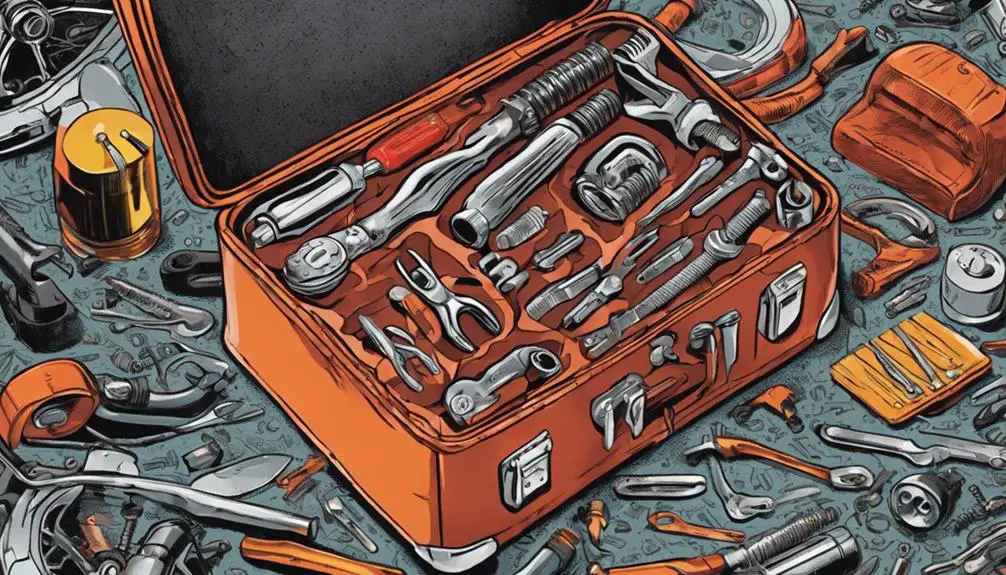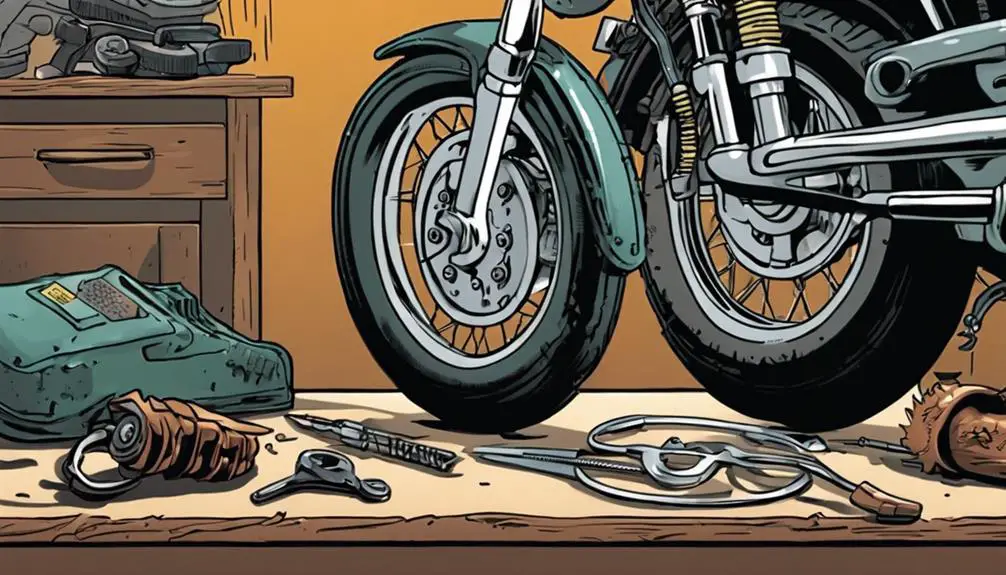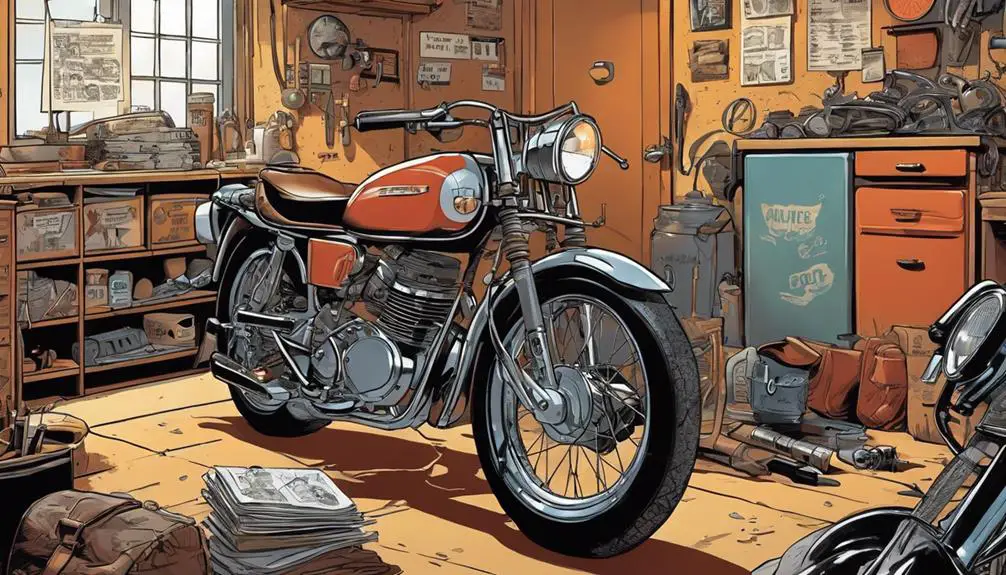Many classic motorcycle owners overlook the importance of regular brake system maintenance, which can greatly affect safety and performance. It's easy to get caught up in the allure of riding, but neglecting crucial checks can lead to costly repairs down the line. You might think you know what to look for, but there are nuances that can make all the difference. By understanding the key components and how to care for them, you can enhance both the longevity of your bike and your riding experience. Let's explore some essential tips that could transform your maintenance routine.
Quick Takeaways
- Regularly change the oil every 2,000 to 3,000 miles to reduce engine wear and maintain optimal performance.
- Inspect and maintain tire pressure, tread, and sidewalls to ensure safe handling and performance.
- Clean and lubricate the chain regularly, keeping it at the proper tension to extend its lifespan.
- Check the electrical system, including battery and wiring, to ensure reliable starting and operation.
Essential Tools for Maintenance

To keep your classic motorcycle running smoothly, you'll need a few essential tools at your side.
First, grab a set of quality wrenches and sockets. These will become your best friends when tackling any nuts and bolts that come your way. A screwdrivers set, including both flathead and Phillips, is vital for those pesky little adjustments and repairs.
Don't forget a reliable torque wrench. It guarantees that you're tightening bolts to the correct specifications, preventing any unnecessary damage. A tire pressure gauge is also important; keeping your tires inflated properly not only enhances performance but also guarantees your safety on the road.
Next, consider investing in a multi-tool. Its versatility can be a lifesaver during unexpected breakdowns. A good-quality chain cleaner and lubricant will help maintain your chain's longevity, while a basic first aid kit guarantees you're prepared for any minor mishaps.
Regular Oil Changes
Regular oil changes are essential for keeping your classic motorcycle running smoothly.
Clean oil reduces engine wear and helps maintain peak performance.
Make sure you know the recommended change intervals for your bike to keep it in top shape.
Importance of Clean Oil
Clean oil is essential for keeping your classic motorcycle's engine running smoothly and efficiently. It acts as the lifeblood of your machine, reducing friction and heat while protecting against harmful contaminants. When you prioritize clean oil, you're not just enhancing performance; you're also extending the life of your beloved bike. Here's why you should focus on maintaining clean oil:
- Engine performance: Clean oil guarantees ideal lubrication, leading to better acceleration and smoother rides.
- Reduced wear: Fresh oil minimizes wear on engine components, allowing your motorcycle to thrive for decades.
- Better fuel efficiency: With less friction, your bike uses fuel more effectively, freeing up resources for the open road.
Recommended Change Intervals
Changing your oil at the right intervals keeps your classic motorcycle running at its best and helps prevent costly repairs down the line.
Regular oil changes are essential for maintaining engine health, especially in vintage bikes that mightn't have the same durability as modern machines. Aim for an oil change every 2,000 to 3,000 miles, or at least once a year if you ride less frequently.
Don't wait until your oil looks dark and gritty; trust your instincts. The freedom of the open road awaits, and you don't want a mechanical failure holding you back. If you ride hard or in extreme conditions, consider changing your oil even more often.
Always check your owner's manual for specific recommendations based on your motorcycle's make and model. Keeping a maintenance log helps you track your intervals and guarantees you're on top of your bike's needs.
Tire Care and Inspection

Proper tire care guarantees your motorcycle handles safely and performs at its best. Neglecting your tires can lead to unsafe rides and diminished freedom on the open road.
Here's what you need to keep in mind for tire maintenance:
- Check the pressure: Always verify your tires are inflated to the recommended levels. This affects handling and fuel efficiency.
- Inspect for wear: Look for tread wear indicators and uneven wear patterns. Replace tires that show significant signs of wear.
- Examine sidewalls: Check for cracks, bulges, or foreign objects lodged in the tire. These can compromise your safety.
Brake System Maintenance
When it comes to your bike's safety, maintaining the brake system is essential.
You should inspect the brake pads regularly to guarantee they're in good condition and replace them if they're worn.
Also, don't forget to check the fluid levels frequently to keep everything functioning smoothly.
Inspect Brake Pads Regularly
To guarantee your safety on the road, regularly inspect your brake pads for wear and tear. Your freedom on two wheels depends on a reliable braking system. Neglecting this vital maintenance can lead to serious consequences.
Here's what you should check during your inspection:
- Thickness: Confirm your pads have enough material left. If they're worn down to about 1/8 inch, it's time for a replacement.
- Cracks or Chips: Look for any visible damage. Cracks can cause brake failure, so don't ignore them.
- Dirt and Debris: Clean your brake pads and surrounding areas. Grime can affect performance and lead to uneven wear.
Check Fluid Levels Frequently
Keeping your brake fluid at the right level is essential for your motorcycle's braking performance. If you want the freedom to ride without worries, checking fluid levels frequently is vital. Low brake fluid can lead to diminished stopping power, increasing the risk of accidents.
To check, locate the reservoir, typically near the handlebars or rear brake. Make sure the motorcycle is on level ground and the fluid is within the marked range.
If it's low, top it up with the recommended fluid type. Don't forget to inspect for leaks, as they can compromise your safety and the joy of riding.
Carburetor Cleaning Tips

Cleaning your motorcycle's carburetor is essential for peak performance and can prevent costly repairs down the line. A clean carburetor guarantees your bike runs smoothly and efficiently, giving you the freedom to ride without worries. Here are some tips to help you get it done right:
- Gather your tools: You'll need a carburetor cleaner, screwdriver, soft brush, and safety goggles.
- Remove the carburetor: Carefully detach it from your bike, keeping track of screws and parts.
- Clean the components: Spray the cleaner on the jets and passages, using the brush to dislodge dirt and debris. Rinse with compressed air, if available.
Regular maintenance not only keeps your carburetor in top shape but also enhances your riding experience.
Embrace the journey of keeping your classic motorcycle in peak condition, and you'll savor every ride with the knowledge that you're taking care of your machine.
Happy riding!
Electrical System Checks
Regular electrical system checks are vital for guaranteeing your motorcycle runs reliably and safely on the road.
Start by inspecting the battery; a healthy battery is your bike's lifeblood. Make sure the terminals are clean and tight, and check the fluid levels if you've got a conventional battery. If the battery's over three years old, consider testing it or even replacing it.
Next, inspect the wiring harness. Look for frayed wires, corrosion, or loose connections—these can lead to electrical failures that could ground your ride. Pay special attention to the ignition system; it's essential for performance. Verify spark plugs are in good shape and properly gapped.
Don't forget to check your lighting. Functioning headlights and taillights make you visible and keep you safe. Test the turn signals, too, as they're crucial for communication with other road users.
Lastly, examine fuses and relays. A blown fuse can cut power to critical systems. Replace any faulty components promptly.
Chain and Sprocket Upkeep

To guarantee smooth performance and extend the lifespan of your motorcycle, it's crucial to maintain the chain and sprockets properly. A well-maintained chain not only enhances your ride but also promotes the freedom you crave on the open road. Here are some key practices to keep everything in top shape:
- Regular Inspections: Check for wear, rust, or damage. A quick visual can save you from major issues down the line.
- Cleaning: Use a suitable chain cleaner to remove dirt and grime. A clean chain is a happy chain, allowing for better movement.
- Lubrication: Apply chain lubricant regularly to reduce friction and wear. This keeps your ride smooth and responsive.
Frame and Body Care
Proper frame and body care guarantees your motorcycle not only looks great but also maintains its structural integrity over time. Start by regularly inspecting the frame for any signs of rust or damage. If you spot any imperfections, address them immediately to prevent further deterioration.
A clean surface is essential, so wash your bike with mild soap and water, avoiding harsh chemicals that could strip protective coatings.
Next, pay attention to the bodywork. Waxing the paint not only enhances its shine but also adds a layer of protection against the elements. Use a quality motorcycle-specific wax, applying it with a soft cloth for the best results.
Don't forget to check and tighten any loose screws or bolts; a well-secured frame contributes to a safer ride.
Additionally, consider applying a protective film or coating to vulnerable areas where wear and tear are common. This simple step can save you from costly repairs down the line.
Finally, keep your bike covered when not in use. A protective cover shields it from dust and UV rays, extending the life of both the frame and the bodywork.
Embrace these practices, and your classic motorcycle will continue to inspire freedom for years to come.
Seasonal Storage Practices

Storing your motorcycle correctly during the off-season is just as important as maintaining its frame and body to guarantee it stays in top condition.
When you give your bike the care it deserves, you're ensuring it'll be ready to ride when the sun shines again.
Here are some essential practices you should follow:
- Clean Thoroughly: Wash and wax your motorcycle to remove dirt and grime that can cause corrosion.
- Fuel Up: Fill the tank and add a fuel stabilizer to prevent the gas from going stale.
- Check Tire Pressure: Inflate your tires to the recommended pressure to avoid flat spots.
Common Questions
How Often Should I Check My Motorcycle's Fluid Levels?
You should check your motorcycle's fluid levels regularly, ideally before each ride. This includes engine oil, coolant, brake fluid, and even your chain lubricant.
If you're planning a long journey, do a thorough inspection. Keeping an eye on these levels guarantees your ride's smooth and safe.
Don't wait for warning lights; take control and be proactive. It's all about that freedom on the road, so keep your bike in top shape!
What Is the Best Way to Clean My Motorcycle's Chrome Parts?
To clean your motorcycle's chrome parts, start by rinsing off any dirt with water.
Then, apply a specialized chrome cleaner or a mix of vinegar and water, and use a microfiber cloth to gently scrub.
For tough spots, a soft-bristle brush can work wonders.
Rinse thoroughly and dry to prevent water spots.
Finally, polish the chrome with a quality polish to shine it up and protect it from future grime.
Feel free to ride with pride!
How Do I Identify Worn-Out Parts Before Maintenance?
Did you know that around 60% of motorcycle accidents are linked to mechanical failures?
To keep your ride liberating, regularly inspect parts like brakes, tires, and chains for wear. Look for cracks, fraying, or unusual noises.
Trust your instincts; if something feels off, it probably is.
What Are Signs of a Failing Ignition System?
When your ignition system starts failing, you'll notice several signs.
Your engine might crank but not start, or it could misfire and run rough.
You may see a decrease in power or experience stalling when you accelerate.
If the dashboard lights flicker or your fuel efficiency drops, it's time to pay attention.
Trust your instincts; these issues signal that your ignition system needs urgent attention to keep your ride smooth and liberating.
Can I Use Automotive Oil in My Motorcycle?
You might think it's okay to use automotive oil in your motorcycle, but it's not ideal.
Motorcycle engines operate differently, requiring oils that can handle higher temperatures and clutch performance.
Using automotive oil could lead to poor lubrication and engine damage.
Instead, choose oils specifically designed for motorcycles, as they'll provide the protection and performance your bike needs.
Your ride deserves the best, so don't compromise on oil quality!
Wrapping Up
In the world of classic motorcycles, maintenance isn't just a chore; it's a labor of love.
By following these tips, you'll keep your ride purring like a contented cat, ensuring it stands the test of time.
Regular check-ups and the right tools can transform your motorcycle into a reliable companion on every journey.
So, roll up your sleeves, embrace the process, and let your classic shine on the road like the timeless beauty it is!